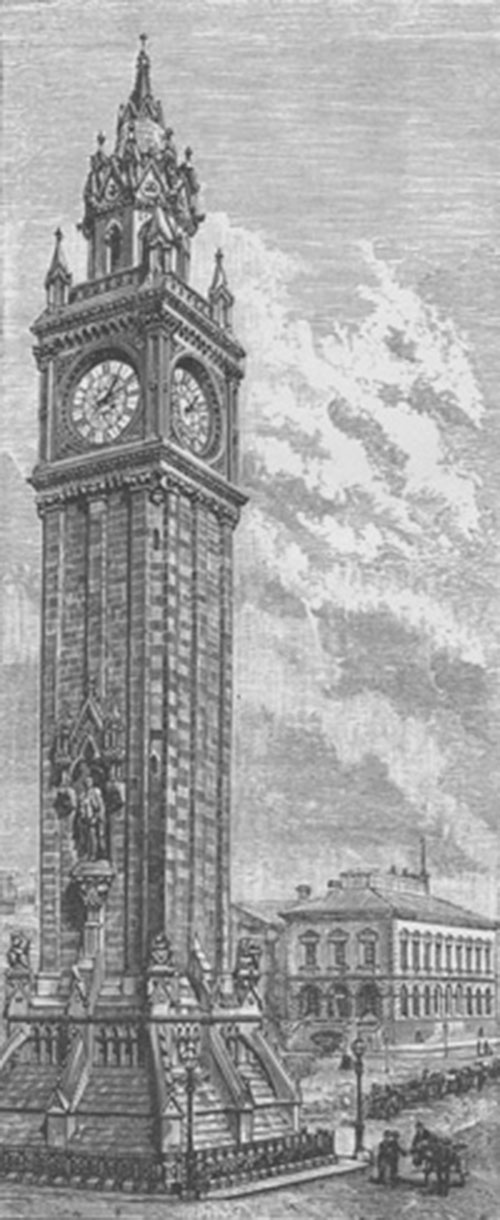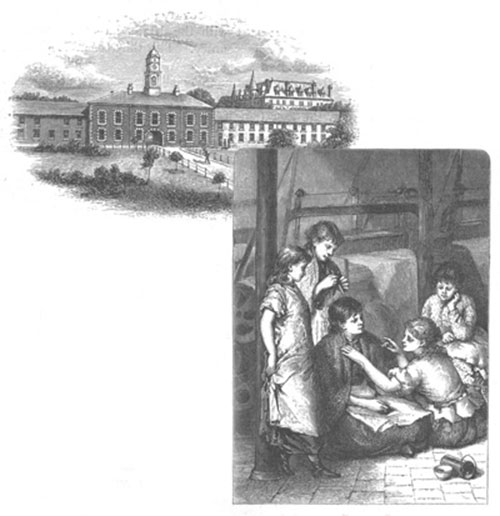Belfast Religion, Trade and Education - Irish Pictures (1888)
From Irish Pictures Drawn with Pen and Pencil(1888) by Richard Lovett
Chapter IX: Belfast, Armagh, and Londonderry … continued
« Previous Page | Start of Chapter | Book Contents | Next Page »
Until the last few years Belfast was to a considerable extent open to the charge, that she was so engrossed in money-making and industrial enterprise as to be indifferent to her outward appearance. But if this accusation were well-grounded in the past there is little basis for it to-day. In both public and private buildings Belfast can hold her own with her great commercial rivals in the United Kingdom. Such buildings as the Custom House, the Town Hall, the new Post Office, the Belfast, the Ulster, and the Northern Banks, and the Albert Memorial are an ornament to any city. Handsome bridges also cross the Lagan.
Religion and education are zealously cared for in the city. The stranger cannot fail to be struck by the number and the excellence of the churches and colleges. Carlisle Circus is adorned with two splendid buildings; St. Enoch's Church, the finest and most imposing building belonging to the Presbyterians, and the Carlisle Memorial Church, a handsome Methodist Church, built by a wealthy merchant in commemoration of his son, who died young. On every hand Presbyterian churches are to be met with. The chief Protestant Episcopal buildings are St. George's Church in High Street, St. Ann's Church in Donegal Street, and Christ Church in College Square North. Roman Catholicism is represented by St. Malachi's in Alfred Street, and St. Patrick's in Donegal Street.
Education is represented in Belfast by the Royal Academical Institution and Government School of Art, the Queen's College, a large and commodious building, and the Model School, where over 1,200 children receive daily instruction. The special requirements of ministerial training are met by the Presbyterian College and the Methodist College. The former institution occupies a fine site at the extremity of the Botanic Avenue, and faces upon University Square. The cost was met by voluntary contributions, and it was opened by Merle d'Aubigne in 1853. The faculty consists of a president and five professors, whose chairs prior to 1871 were endowed by the State to the amount of £250 a year. Recently Magee College, at Londonderry, a large building occupying a fine site overlooking the Foyle, has been erected, and is also carried on as a college for Presbyterian ministers. A few years ago the theological professors of the two colleges were constituted 'the Presbyterian Theological Faculty (Ireland),' and 'empowered to grant the usual degrees in theology equal to those conferred by any university in the United Kingdom.'
The Methodist College, opened in 1868, cost £25,000, and is an extensive and handsome pile of buildings. It comprises a theological institute, a collegiate department in connection with Queen's College, and a boarding and day school.
It is needful that a few words should be said about the religious condition of Ireland, and these naturally occur in connection with the great Protestant stronghold of the country. The religious forces that have influenced Ireland in the past, and that are most powerfully influencing her to-day, run in the three channels represented by the Roman Catholic, the Protestant Episcopal, and the Presbyterian Churches. Of these the first is all-powerful in the south and west and in County Donegal. The second, by reason of its connection in the past with the State, has a net-work of buildings and parsonages over the whole country. The third is most powerful in Counties Antrim, Down, and Londonderry.
The Roman Catholic section far outnumbers all the others put together, comprising, according to the 1881 census, 3,951,818 adherents. It wields enormous power, owing to the fact that it forms an integral part of the life of the people, is essentially the Church of the 'Mere Irish,' and a very large proportion of the priesthood comes from the tenant farmer and peasant class.
The Protestant Episcopal Church of Ireland numbered, according to the census of 1881, 639,574 adherents. Since 1871 the supreme governing body has been the General Synod, which meets annually, and is composed of the archbishops, bishops, 208 clerical and 416 lay representatives. There are also twenty-one Diocesan Synods under the control of the General Synod. The Book of Common Prayer has been revised and slightly altered, but the Thirty-Nine Articles of the Church of England were adopted unchanged. The invested capital of the Church amounts to about £7,000,000. The great educational centre is at Trinity College, Dublin. To this Church belong many of the wealthier and of the official class of the country. The Act of 1869 severed its connection with the State, and all interested in the religious welfare of Ireland heartily wish the Episcopal Church prosperity in its reliance to a much larger extent upon voluntaryism. On the once bitterly controverted question, whether the Church should be connected with the State, and whether the disestablishment was a just act or not, opinions may, and probably do still differ. But the experience of history should give confidence for the future to all the earnest workers and well-wishers of the Episcopal Church.
The Presbyterian Church of Ireland, according to the census of 1881, numbered 485,503 adherents. Of these the vast majority reside;n Central and North-eastern Ulster. Into the various Christian activities of this branch of the Church we have no space to go. Although doing good work in many parts of the country, it is chiefly among the agricultural and commercial classes of Ulster that the great body of their adherents is found. The ecclesiastical affairs are administered by the General Assembly which meets annually, having under its control thirty-six presbyteries, more than 500 churches and 600 ministers. The communicants number considerably over 100,000. It raises annually for religious and philanthropic purposes more than £150,000 a year; and it controls the two colleges already described. No careful observer can fail to see signs of still greater prosperity for this Church in the future. In addition to these three great bodies there are also scattered through the country—each body doing very good service—Methodist, Congregational, and Baptist Churches.
Belfast is not only the centre of a strong religious and philanthropic life, it is also the great commercial and manufacturing centre of Ireland. The linen trade is the great staple, and many large linen factories and flax-spinning mills are to be seen there. Naturally many other business occupations flourish there also. Such firms as Musgrave & Co., Marcus Ward & Co., Harland and Wolff, have a world-wide reputation. Yet, while in Belfast all the varied industries that necessarily centre in a city of over 200,000 inhabitants are to be seen in full activity, the stranger will naturally devote his attention to the two chief—the linen manufacture and ship-building. At such an institution as the York Street Spinning Mills he can study the former to advantage; and at Messrs. Harland and Wolff's the latter.
« Previous Page | Start of Chapter | Book Contents | Next Page »


